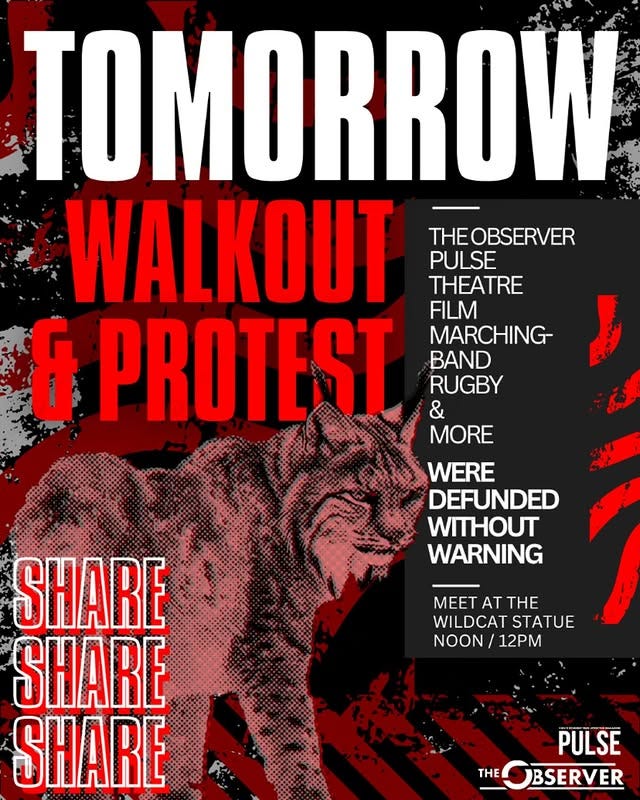Washington student publications lead campus walkout after deep funding cuts
‘It’s a fine line’ between reporting and advocacy, editors-in-chief say amid fight to save newsrooms

Faced with more than 90% in proposed funding cuts to Central Washington University’s student newspaper and magazine, student journalists at The Observer and PULSE decided to do more than just report the news.
They turned their front pages into calls for support, transformed their Instagram into protest platforms and organized a campus-wide walkout last week that drew more than 300 participants — far more than they expected.
“We were trying to let the audience know that this isn’t just a regular business-as-usual type of issue,” said Jackson Roberts, The Observer’s co-editor-in-chief. “We wanted to make it stand out a lot more, have the audience recognize how big of a problem this is.”
The editors acknowledged they were navigating what they described as a “fine line” between reporting the story and being part of it, advocating for something they argued is much larger than just their newsrooms.
The campaign launched in early April, after the student journalists learned of near-total cuts to their operating budgets.
Those funds come from student fees allotted by the Services and Activities Committee, a student committee nominated by the Faculty Senate.
The Observer is slated to receive $1,100 of its requested $56,375. PULSE is set to receive $2,000 of the $28,412 requested. Editors say those amounts are nowhere near enough to sustain operations. A campus literary journal and other student groups are facing similar cuts, according to a petition circulating online.
The committee cited funding guidelines stating that student media tied to for-credit classes cannot be supported by student fees. But the same guidelines also say S&A fees can fund student publications.
In meeting minutes, committee members admitted the decision “feels wrong and is very sad.”
“I think for more than just us, this is about advocating for student voices and having what the students want represented within the university,” said Gunner Stuns, EIC of PULSE, which publishes an 80-page magazine quarterly.
At the May 7 rally, students walked out of classes at noon, then marched around campus after delivering speeches. The university’s Board of Trustees is expected to make a final decision on the proposed budget this week.
David Leder, a university spokesperson, told The Nutgraf that the administration will recommend the board approve the S&A Committee’s proposal and is exploring alternative funding sources for student media.
Leder explained the funding decisions were made solely by the student-led committee, which had been asked by the administration to cut 20% from its overall budget.
“CWU also supports our students in making their dissatisfaction heard, whether it’s through protest or through their reporting,” Leder wrote. “The voices of our students are at the core of our identity as an institution, and we encourage their civic engagement on the issues that matter most to them.”

Ahead of the rally, more than 430 people signed the petition urging the board to reject the student government’s proposal. Nearly 100 people attended an S&A Committee meeting to protest the cuts.
Brandon Mattesich, co-EIC of The Observer, said deciding to launch the campaign wasn’t easy. The difference between journalism and activism, he said, is clear — but so is the threat.
“First, we’re looking at this from the journalist perspective of like, there’s a very clear story here, which is that this 110-year-old newspaper is being defunded,” he said. “That newspaper just happens to be us.”
As the cuts began to feel inevitable, he said, the staff leaned into their motto: “by the students, for the students.”
“We asked ourselves, ‘What’s the best way to use our platform?’” he said. “And we decided that was to advocate not just for us, but for a lot of other programs that have been cut.”
For PULSE, Stuns said the magazine’s mission is to cover all facets of student life, good and bad. Ignoring the cuts, he said, would be a disservice.
“We have a duty to our reader base to let them know this magazine you hold in your hands very well may be the last one,” Stuns said. “And this source that you've gone to for these aspects of student life, this story of us and our campus and our peers and ourselves could disappear.”

Rallying the community
In recent issues, The Observer’s front page headlines have included: “Observer And Pulse Funding Threatened,” “S&A's Defunding of The Observer Will Silence Student Voices” and “Budget Cuts Affect Student Lives.”
Each edition has included coverage of the cuts’ impact, editorials, letters from readers and QR codes linking to the petition.
On Instagram, both PULSE and The Observer have traded in traditional newsroom aesthetics for protest visuals, posting calls to walk out, protest and sign the petition.
“We’re definitely using our platform in an untraditional way,” Mattesich said. “We’re kind of taking a stance here. I think the key concept for us is just big and bold.”
The Instagram visuals, he said, intentionally mirror traditional protest art mixed with “sportsy” design. That strategy of breaking the typical newsroom aesthetics, he said, is meant to convey that the norm of the newspaper’s being funded is also being broken.
That approach has resonated with the campus community. Some professors canceled classes or offered excused absences so students could attend the rally. The turnout, student journalists said, was unexpected and overwhelming.
Roberts said he’s seeing more students pick up the print editions. Stuns called it a “magnificent display” of solidarity.
“I mean, what an overwhelming sense of community to see everyone come together, more than just us, in support of our program and their own voice and each other,” Stuns said. “It’s been eye-opening for me, I think, to see how truly united we are.”
Walking the ‘fine line’
The three editors are conscious of the balance they’re trying to strike.
Mattesich said ignoring the story isn’t an option — it’s the biggest news on campus. But the newsroom remains committed to covering other student perspectives, too.
“We’re getting both sides,” he said. “We’re interviewing members of the actual committee, we’re going to meetings, we’re asking them questions.”
Meanwhile, he added that The Observer is intentionally separating coverage of other topics, like the ongoing student elections, to ensure unbiased reporting.
“As an outlet, we have to remain unbiased,” he said. “But as an advocacy for ourselves and for these other programs, we do have to put our opinion out there a little bit.”
Roberts agreed.
“We couldn’t just sit here and let what’s happening kind of happen,” he said. “We have to act as that voice that we’ve been for the students and just cover all these other places that are seeing the same issue that we’re facing right now.”
Correction: Gunner Stuns’ name was spelled incorrectly in the original version. It has been fixed.
💬 I want to hear from you! Can journalists be advocates at the same time? Where do you draw the line? Email me at nutgrafnews@gmail.com.
Story Spotlight:
✉️ Whitman College's dean of students sent a cease-and-desist letter to The Wire, demanding a retraction of a story on the college’s handling of sexual violence, calling it false and defamatory. The student paper published the letter and stood firm: “We are going to remain unafraid,” the editor told Northwest Public Broadcasting.
👮 The Berkeley Beacon faced backlash after publishing police bodycam footage showing force used during a pro-Palestinian protest. Protesters said the report endangered the community; journalists defended it as doing their job.
🎓 A Columbia radio student journalist covered a pro-Palestinian protest. Her graduation has come under threat, the CJR reported.
📝 A Virginia school board is set to vote on a policy that would give the school broad control over student journalism, allowing it to edit or block stories. The board would become the publisher, with the principal as editor and the faculty advisor as co-editor.
🧑⚖️ A Kentucky judge ordered the University of Kentucky to provide the student newspaper Kentucky Kernel with requested documents after an Open Records Act lawsuit.
Featured Opportunities:
The Wildlife Society has an opening for a paid wildlife policy and communications intern position. Apply by May 14.
NYC public high school student: Apply to The Bell’s Summer Youth Podcast Academy before May 18.
NBC Universal is looking for Emerging Producer Fellows, in partnerships with AAJA, NABJ and NAHJ, to attend their 2025 conferences. Deadline’s May 19.
Hazze Media is looking to fill several internship positions, including entertainment, lifestyle and culture reporting role. Deadline’s May 19.
The application window for the 2025-26 Chips Quinn Reporter Fellowship has been extended to May 23.
The 19th’s news product fellowship extended its application deadline to May 30.
WINK News in Fort Myers, Florida, is looking for a news intern.
Applications for The Times Corps at The New York Times are open through June 20.









